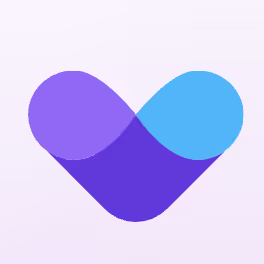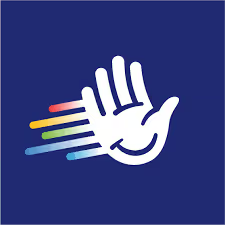Dialpad Alternatives
Looking for a Dialpad alternative? This guide compares 10 other business phone systems to help you find the right fit for your company.

Dialpad is a popular choice for many businesses, and for good reason. It offers a feature-rich VoIP solution with high-quality audio and video. Its AI-driven call summaries and general ease of use make it a strong contender for many communication needs.
However, no tool is perfect. Some users report occasional call issues, connection problems, or find it expensive. This has led many to explore other options. We've analyzed top alternatives to help you compare them against Dialpad. Let's get started.
11x: Digital Workers for Sales
For sales teams looking to expand their efforts, digital workers are an option. 11x offers autonomous agents to manage sales tasks. This allows your human team to concentrate on higher-value activities. See if this approach aligns with your company's sales objectives.
11x is a GTM platform that uses AI agents to manage the sales process. An agent named Alice finds prospects, handles outreach via email and LinkedIn, and updates the CRM. Julian, another agent, qualifies inbound leads and books meetings. The platform unifies data enrichment, outreach, and email warmup, removing the need for separate tools.
Dialpad Alternatives
Here is a detailed breakdown of top Dialpad alternatives. We examine each option's pricing, core features, and its specific pros and cons when measured against Dialpad.
1) RingCentral MVP
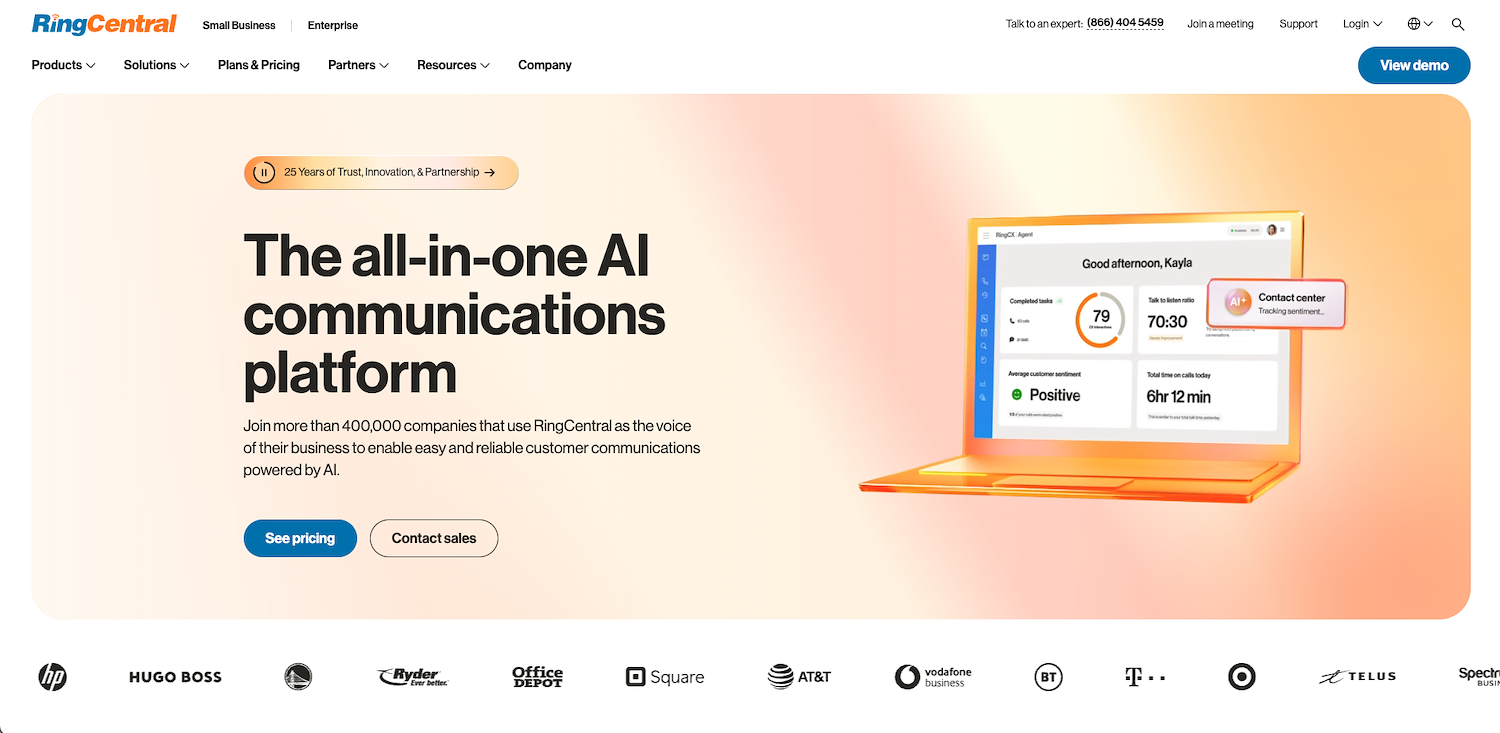
RingCentral MVP is a unified communications platform and a common Dialpad alternative. It provides solutions for business communications, with a focus on meetings and conference calls. The system integrates phone, video, and messaging capabilities into a single application to support various business communication needs.
RingCentral MVP's Main Features
- Integrates phone, video, and messaging capabilities into a single application.
- Provides solutions with a focus on business meetings and conference calls.
- Functions as a unified communications platform to support various business communication needs.
How RingCentral MVP Compares to Dialpad
Average Review score: 4.0/5 stars based on 154 G2 reviews.
- RingCentral MVP supports over 30 digital channels, including social media and email. This provides more ways for customers to connect compared to Dialpad's main focus on voice and messaging.
- The tool provides access to over 300 prebuilt integrations. This extensive library offers more connectivity options than the standard integrations available with Dialpad.
- It includes advanced AI for customer self-service, such as Intelligent Virtual Agents. This differs from Dialpad's AI, which centers on call summaries and transcriptions.
- The platform has a fully integrated workforce engagement management solution. This is a specialized feature for team analytics and management not found in Dialpad's core product.
Potential Drawbacks Compared to Dialpad
- Some users report occasional call quality issues with RingCentral MVP. This is different from Dialpad, which is often noted for its consistent high-quality audio and stable connections during calls.
- The platform's AI focuses on customer self-service and virtual agents. This contrasts with Dialpad's AI, which provides real-time call transcriptions and automated summaries directly to sales and support teams.
- Its extensive features can sometimes make the initial setup more complex. Dialpad, in comparison, is frequently highlighted for its straightforward interface and quicker implementation process for new teams.
- The pricing structure can be on the higher side, especially for smaller teams. This might make it a more significant investment compared to some of Dialpad's pricing plans.
Pricing and Cost-Effectiveness
Dialpad’s pricing starts at $15 per user per month for its Standard plan when billed annually, offering a clear entry point. While RingCentral MVP does not provide specific public pricing, it is generally considered a higher-cost platform, making Dialpad a more budget-friendly option for smaller teams.
2) Zoom Phone
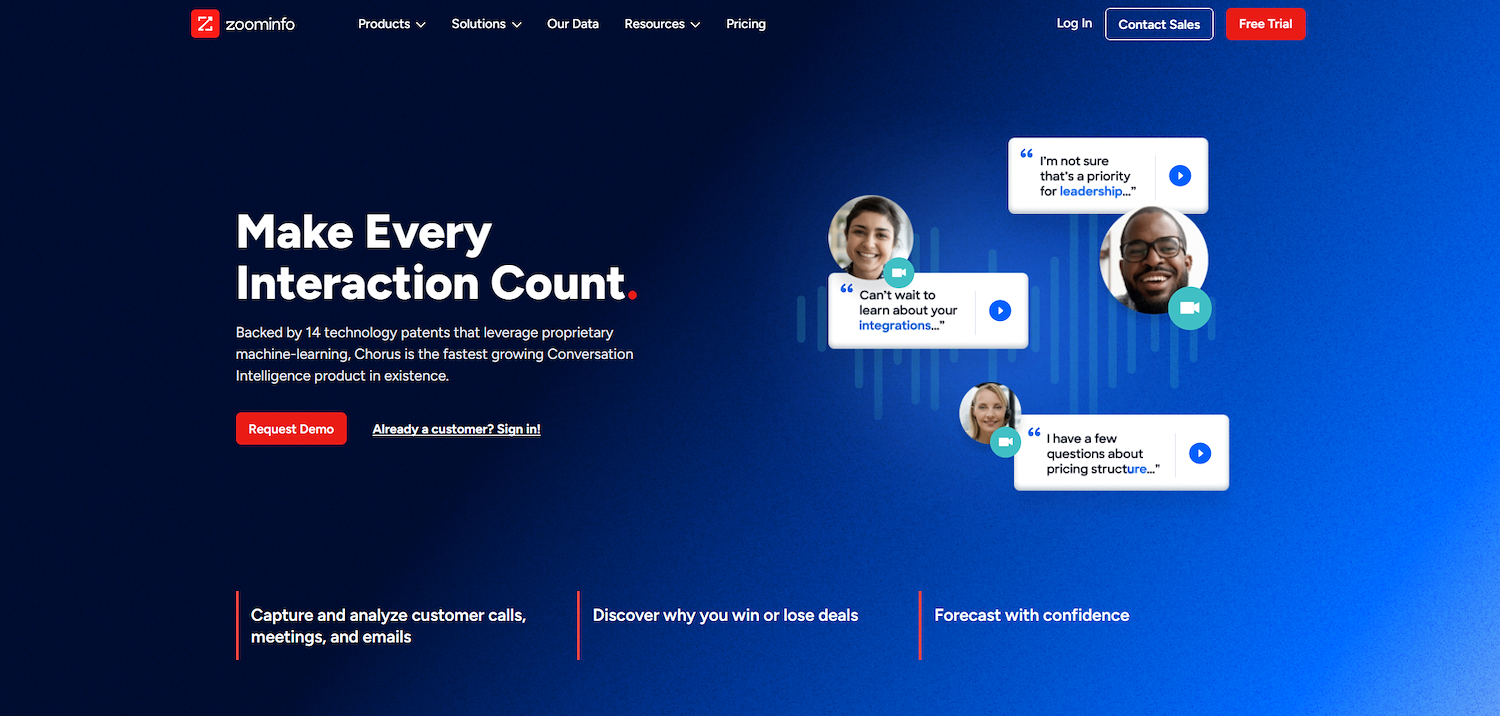
Zoom Phone is a cloud phone system integrated into the Zoom platform. It combines voice calls, video meetings, and chat within one application. The service supports calls through the public switched telephone network (PSTN).
This system suits businesses that use Zoom for video conferences and want to add phone functions. The consolidation simplifies communication for teams that depend on frequent meetings and calls.
Zoom Phone's Main Features
- It combines voice calls, video meetings, and chat functions into a single application.
- The system integrates directly into the Zoom platform, adding phone capabilities for existing users.
- It provides connectivity to the public switched telephone network (PSTN) for making and receiving external calls.
How Zoom Phone Compares to Dialpad
Average Review score: 4.6/5 stars based on 2,481 G2 reviews.
- Zoom Phone is built directly into the widely used Zoom platform, which combines phone, chat, and video meetings. This creates a familiar environment for teams already using Zoom, while Dialpad operates as a separate unified system.
- Its AI Companion can extract actionable tasks from voicemails. This differs from Dialpad's AI, which focuses more on generating summaries and transcriptions from live calls.
- The tool uses AI to prioritize voicemails based on urgency, helping users manage follow-ups. In comparison, Dialpad's AI provides post-call analytics rather than organizing voicemails.
- It offers a summary feature for Team SMS threads, allowing users to catch up on text conversations quickly. This is a specific messaging function not highlighted in Dialpad's core features.
Potential Drawbacks Compared to Dialpad
- Zoom Phone's AI assists with post-call tasks like voicemail summaries. It does not offer the real-time transcription and live coaching features found in Dialpad's AI.
- Some users report occasional call quality issues, such as lag or drops. This contrasts with Dialpad, which is often highlighted for its stable connections and clear audio.
- Its integration into the broader Zoom platform can make the setup of advanced phone features seem complex to some teams. In contrast, Dialpad is often noted for its straightforward and quick implementation.
Pricing and Cost-Effectiveness
Dialpad's Standard plan and Zoom Phone's US & Canada Unlimited plan both start at $15 per user per month. However, Zoom Phone's higher-tier plans ($18.32-$22.49) are more cost-effective than Dialpad's Pro plan ($25). For the most current information, visit Zoom Phone's official website.
3) 8x8 X Series
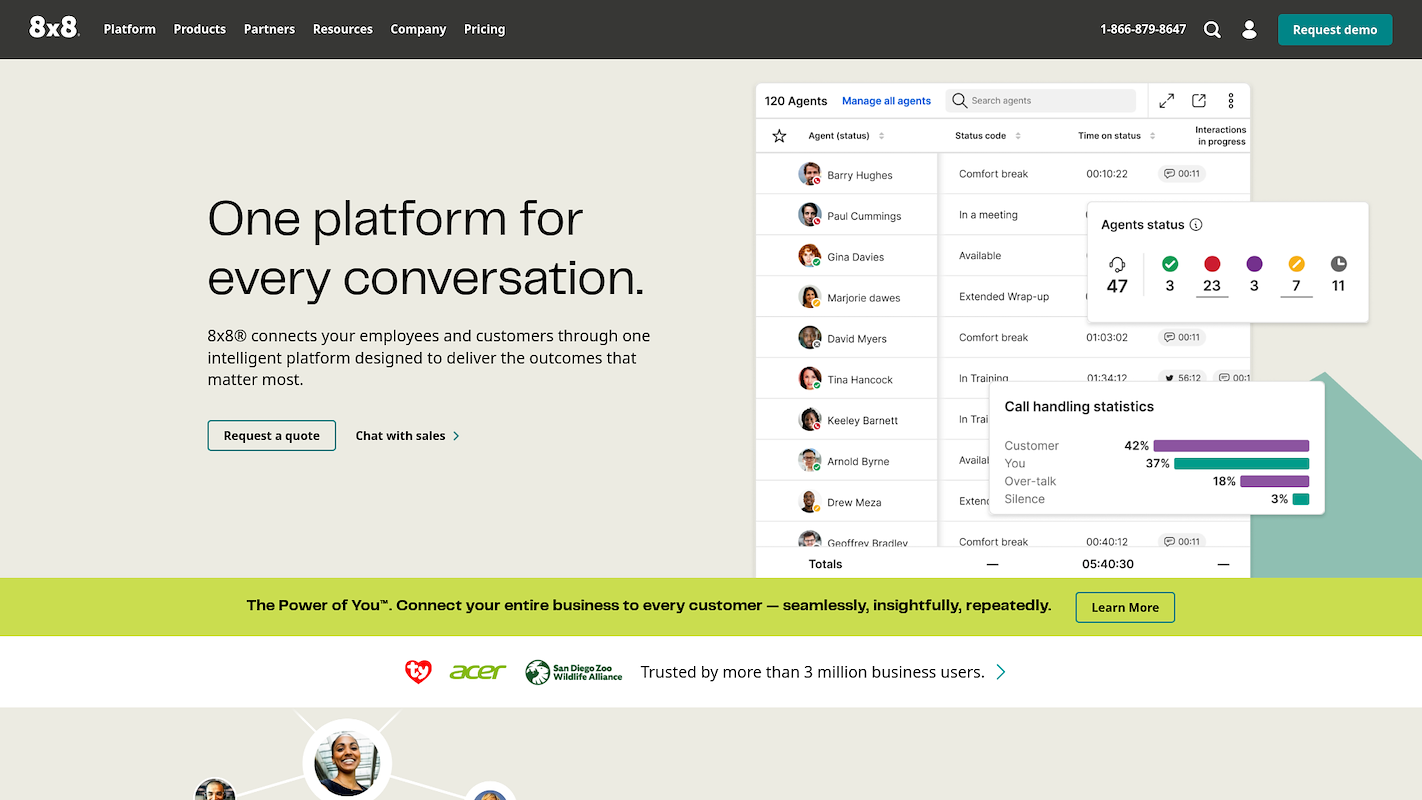
8x8 X Series is a cloud communications platform that unifies contact center, voice, video, and chat into a single solution. It is designed to connect employees and customers through one platform for every conversation.
The system consolidates various communication tools and supports global calling for distributed workforces. This helps businesses modernize their systems and improve operational efficiency.
8x8 X Series's Main Features
- It provides an omni-channel contact center with built-in AI to manage customer operations.
- The platform offers no-code and low-code APIs to embed voice, SMS, and chat into any application.
- It equips customer-facing teams outside the contact center, such as sales and service, with CX tools through 8x8 Engage.
- The system adds enterprise telephony and contact center functions natively inside Microsoft Teams.
How 8x8 X Series Compares to Dialpad
Average Review score: 4.2/5 stars based on 765 G2 reviews.
- 8x8 X Series guarantees 99.999% uptime with its service level agreement and offers coverage in over 55 countries, providing a specific reliability commitment for global teams.
- It supports large video meetings for up to 500 participants and allows live streaming to YouTube, a capacity designed for large-scale events not detailed in Dialpad.
- The tool adds native enterprise telephony and contact center functions directly inside Microsoft Teams, offering deeper integration for companies that use the Microsoft ecosystem.
- Its platform includes no-code and low-code APIs to embed communication features into other applications, allowing for more extensive customization than standard integrations.
Potential Drawbacks Compared to Dialpad
- 8x8 X Series provides AI-generated summaries after a meeting concludes. This differs from Dialpad's AI, which offers live transcriptions and coaching during active calls to assist teams in real time.
- Some users report that the platform's extensive features can make its interface feel complex. In comparison, Dialpad is often noted for its straightforward user experience, which can allow for quicker team adoption.
- The mobile application for 8x8 can sometimes experience glitches, according to user feedback. This contrasts with Dialpad, which is generally recognized for its stable mobile performance for on-the-go communication.
Pricing and Cost-Effectiveness
Dialpad's pricing starts at $15 per user per month for its Standard plan. 8x8 X Series does not list public pricing due to its mix-and-match plans; for accurate cost details, visit the 8x8 X Series's official website.
4) Nextiva
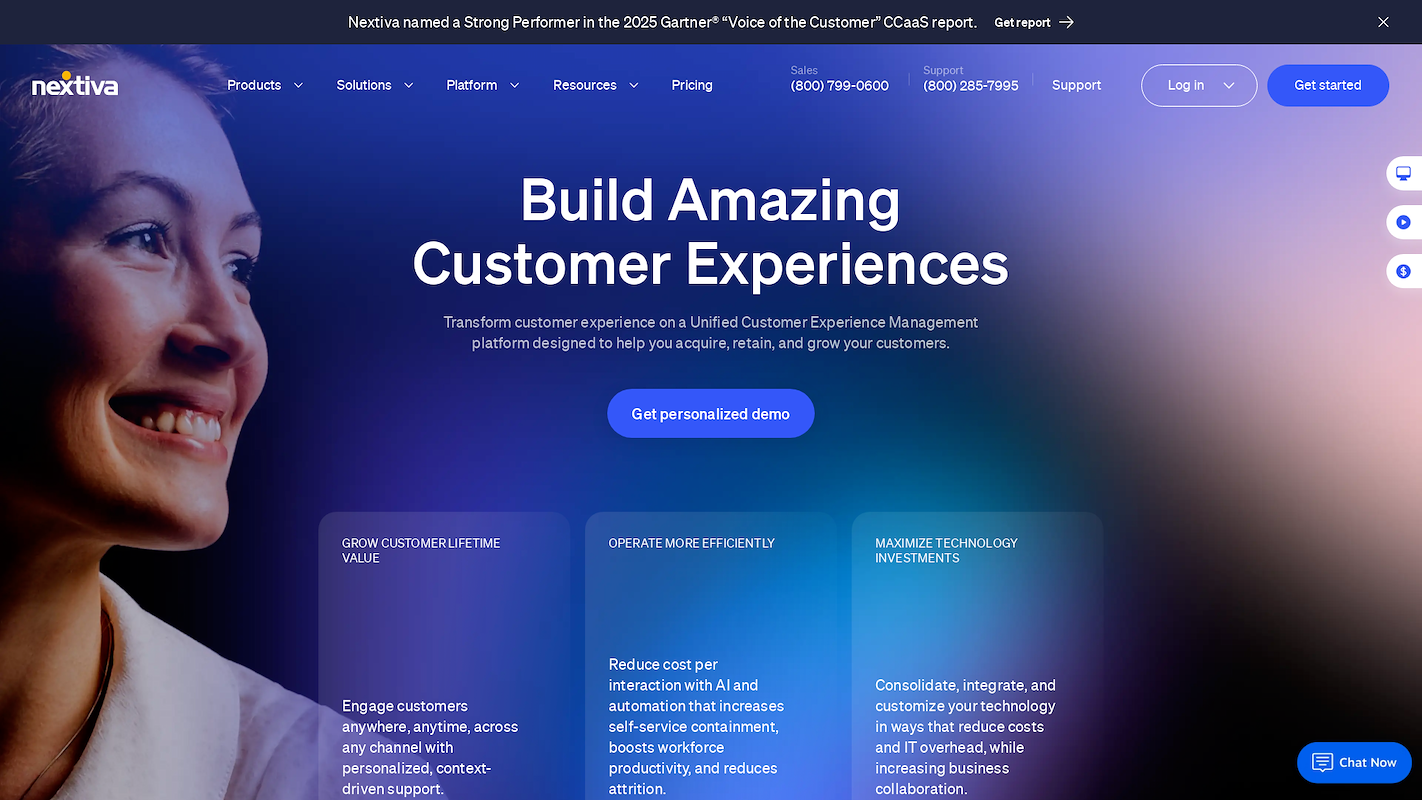
Nextiva is a communications platform that combines business phone, video conferences, and team chat into a single application. It helps manage customer interactions across different channels.
The system offers HD video and audio for meetings, along with screen share functions and call records. It suits companies that handle sales, service, and remote work and require one tool for these tasks.
Nextiva's Main Features
- Consolidates all customer touchpoints, including voice, chat, email, and social media, into a single workspace.
- Orchestrates end-to-end customer journeys using a patented workflow engine for automation.
- Provides an AI-powered contact center with skills-based routing and an Intelligent Virtual Assistant.
- Includes a secure payment agent assist feature for collecting payment information during live calls.
How Nextiva Compares to Dialpad
Average Review score: 4.5/5 stars based on 3,333 G2 reviews.
- Nextiva consolidates customer touchpoints like email and social media into one workspace, offering a wider channel range than Dialpad's focus on voice and messaging.
- The platform includes a patented workflow engine to automate customer journeys, a process management tool not central to Dialpad's platform.
- It provides an AI-powered contact center with an Intelligent Virtual Assistant for customer self-service, whereas Dialpad's AI focuses on live agent assistance and call summaries.
- A secure payment agent assist feature allows teams to collect payment information during calls, a specialized function that Dialpad does not offer.
Potential Drawbacks Compared to Dialpad
- Nextiva's AI does not provide live transcriptions or in-call coaching. This is different from Dialpad's AI, which assists agents in real time during active conversations.
- Some users report that the platform's extensive features can make navigation feel complex. In comparison, Dialpad is often noted for its straightforward interface that allows for a quicker setup.
- The tool can sometimes experience call quality or connection issues, according to user feedback. This contrasts with Dialpad, which is generally recognized for its stable performance and clear audio.
Pricing and Cost-Effectiveness
Dialpad offers a lower entry price with its Standard plan at $15 per user per month, compared to Nextiva's starting Digital plan at $20. This cost difference continues with higher tiers, making Dialpad a more budget-friendly option for teams looking for core communication features.
5) GoTo Connect

GoTo Connect is a unified communications platform that merges phone, video conference, and message features into one application. It provides a single tool for businesses to manage internal collaboration and customer interactions. The system is designed for companies that want to consolidate their various communication tools into one place.
GoTo Connect's Main Features
- It includes a visual dial-plan editor that allows for the creation of call flows using a drag-and-drop interface.
- The platform offers an AI Receptionist, a 24/7 assistant for answering calls and automating routine tasks.
- It provides an omnichannel customer experience suite that integrates digital channels like SMS, web-chat, email, and social media.
- The AI-powered contact center supports voice, email, chat, and WhatsApp integrations for customer communication.
How GoTo Connect Compares to Dialpad
Average Review score: 4.4/5 stars based on 1,339 G2 reviews.
- GoTo Connect includes a visual dial-plan editor. This tool lets users create custom call flows with a drag-and-drop interface, which provides more flexibility than Dialpad's standard routing options.
- An AI Receptionist answers and routes calls automatically. This differs from Dialpad's AI, which focuses on live call transcription and post-call summaries for agent analysis.
- The platform offers an omnichannel suite to unify communication from channels like social media and web-chat. This provides a wider range of customer contact points compared to Dialpad's primary focus on voice and SMS.
- Its service level agreement guarantees 99.999% uptime. This offers a specific reliability commitment that is not explicitly detailed in Dialpad's standard plans.
Potential Drawbacks Compared To Dialpad
- GoTo Connect provides an AI Receptionist to route calls. This differs from Dialpad's AI, which gives agents live transcriptions and coaching during calls to help them in real time.
- The tool's interface can sometimes feel complex to navigate for new users. Dialpad, in contrast, is often highlighted for a simpler design that helps teams get started more quickly.
- Some users report occasional call quality issues, such as drops or lag. In comparison, Dialpad generally provides stable connections and clear audio during calls.
Pricing and Cost-Effectiveness
Dialpad's Standard plan is priced at $15 per user per month, while GoTo Connect's entry-level Basic plan starts at $27. Even Dialpad's more advanced Pro plan at $25 is less expensive than GoTo Connect's basic offering, positioning Dialpad as the more budget-friendly option.
When to Choose 11x for Sales
If your goal is sales process automation, 11x offers a different path. Its digital workers manage outreach and CRM updates. This frees your sales team to focus on the final stages of a sale. Consider this approach if you need to scale your sales operations efficiently.
With 11x, AI agents run your sales process from start to finish. An agent named Alice finds accounts and manages outreach, while Julian handles calls, qualifies leads, and sets up meetings. The platform unifies data enrichment and outreach, which removes the need for multiple tools.
Book a demo to see the platform in action.
6) Vonage Business Communications
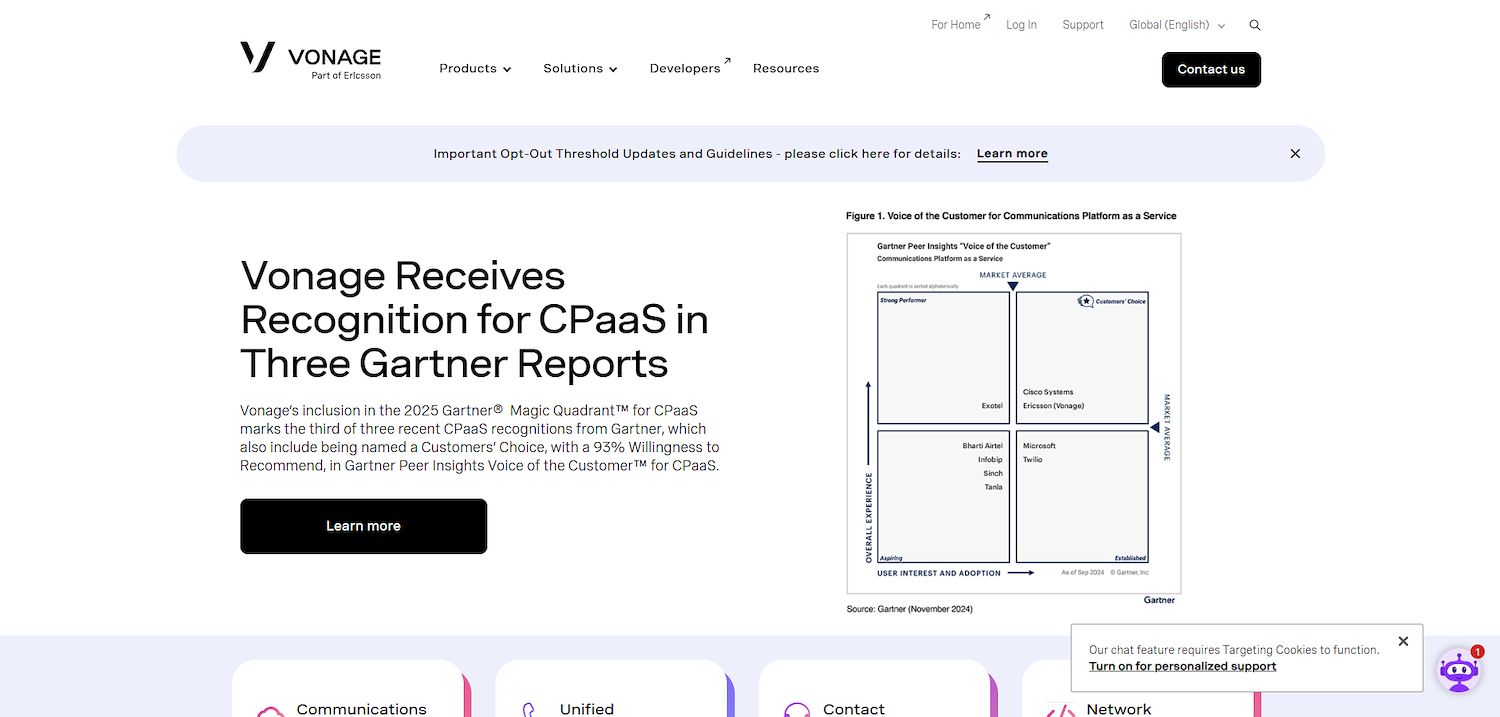
Vonage Business Communications is a unified communications platform that combines voice, video, and message features. The system connects employees with customers and supports hybrid work models. It provides tools for video meetings and conference calls to help teams collaborate from different locations and modernize their communication systems.
Vonage Business Communications's Main Features
- Unifies global voice, video, SMS, and collaboration tools on a single platform.
- Offers communications APIs to embed messaging, voice, and video services into other applications.
- Provides cloud contact center capabilities that include speech analytics and omnichannel routing.
- Exposes advanced carrier-grade network functions through its Network APIs for building applications.
How Vonage Business Communications Compares to Dialpad
Average Review score: 4.3/5 stars based on 484 G2 reviews.
- Vonage Business Communications provides communications APIs to embed voice and messaging into other applications, which allows for more in-depth customization compared to Dialpad's standard set of integrations.
- The platform offers a service level agreement that guarantees 99.999% uptime. This provides a specific reliability commitment that is not detailed in Dialpad's standard offerings.
- It operates on a no-annual-contract basis, which gives businesses the flexibility to cancel service at any time. This model differs from Dialpad's pricing, which is typically based on annual commitments.
- The service highlights its multiple direct support channels, including phone, email, and chat. This focus on accessible support offers a different approach than the tiered support plans common to many platforms.
Potential Drawbacks Compared To Dialpad
- Vonage Business Communications does not offer real-time AI assistance. This is different from Dialpad, which provides live call transcriptions and in-call coaching to help teams during active conversations.
- Some users report that the platform can experience call drops or connectivity problems. In comparison, Dialpad is generally recognized for its stable connections and consistent audio quality.
- Its mobile application may have some limitations with messaging. For example, users sometimes cannot reply to or edit texts, which differs from the more complete mobile features offered by Dialpad.
Pricing and Cost-Effectiveness
Dialpad's Standard plan starts at $15 per user per month with an annual subscription. While Vonage Business Communications does not provide public pricing, it operates on a no-annual-contract model, offering more payment flexibility. For the most accurate cost information, we recommend visiting the official Vonage website.
7) Aircall
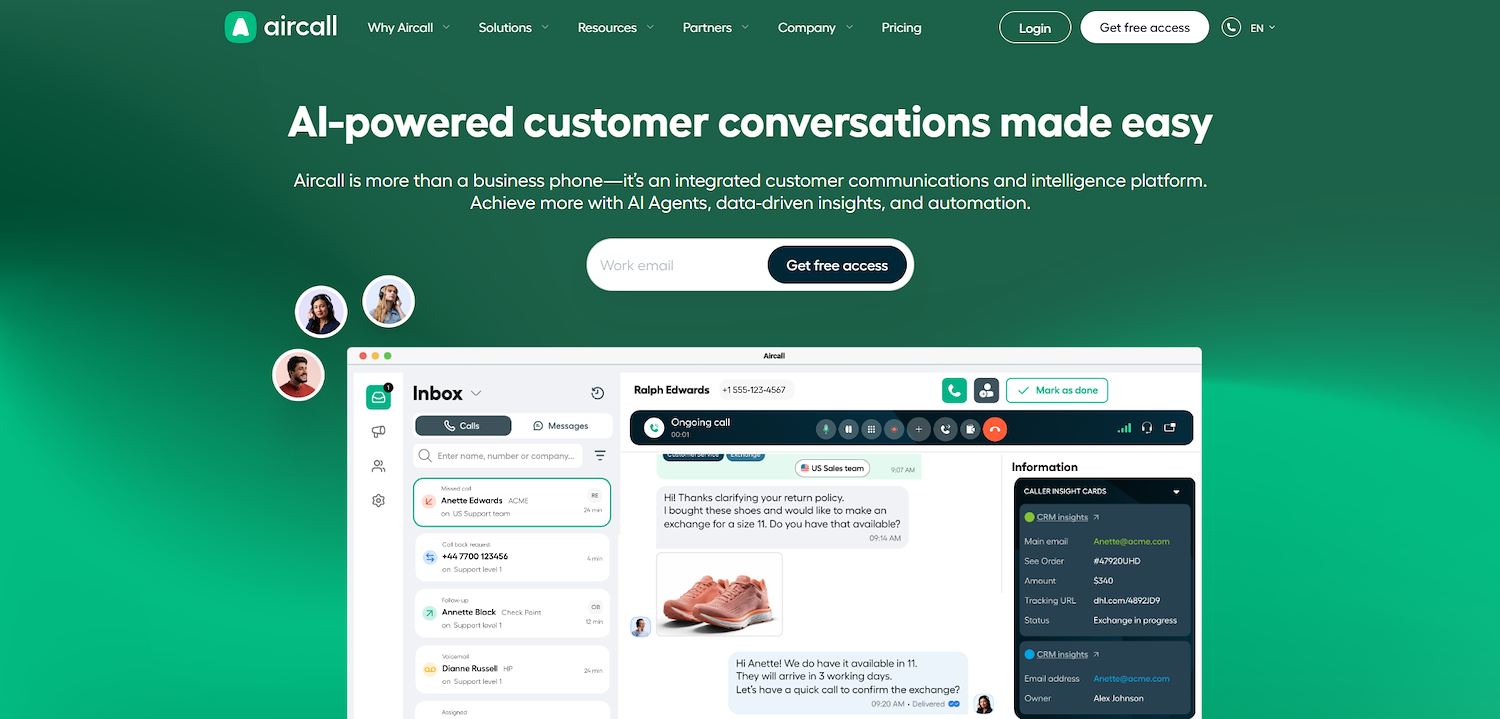
Aircall is a cloud phone system built for sales and customer service teams. It provides voice and conference call functions and connects with business tools like CRMs and helpdesks. This setup allows teams to handle customer interactions and communication workflows from one platform, which supports both sales and support operations.
Aircall's Main Features
- Provides a 24/7 virtual agent to autonomously handle, qualify, and route inbound calls.
- Manages WhatsApp conversations alongside calls and texts within a single workspace.
- Includes a power dialer to automate outbound sales prospecting calls.
How Aircall Compares To Dialpad
Average Review score: 4.4/5 stars based on 1,314 G2 reviews.
- Aircall provides a 24/7 virtual agent to handle and route inbound calls. This automates initial customer contact, which differs from Dialpad's AI that assists live agents during calls.
- The platform integrates WhatsApp conversations directly into the main workspace. This gives teams an extra communication channel beyond the standard voice and SMS options in Dialpad.
- It includes a power dialer to automate outbound calls for sales teams. This function helps increase call volume, a specific tool not emphasized in Dialpad's feature set.
- With bi-directional syncing for over 100 apps, Aircall ensures data flows smoothly between tools. This offers a more connected system than the standard integrations found in Dialpad.
Potential Drawbacks Compared To Dialpad
- Aircall's AI focuses on routing inbound calls. This is different from Dialpad's AI, which provides live transcriptions and coaching to assist agents during active conversations.
- Some users report that Aircall can experience call drops or connectivity issues. In comparison, Dialpad is generally recognized for its stable connections and consistent audio quality.
- The tool's mobile application sometimes has limitations with messaging. For example, some users note the SMS interface can be clunky, which differs from the more complete mobile features offered by Dialpad.
Pricing and Cost-Effectiveness
Dialpad is more budget-friendly, with its Standard plan at $15 per user per month. Aircall's entry-level Essentials plan costs $30 per user per month and requires a three-user minimum, making Dialpad a more accessible option for smaller teams.
8) Ooma Office
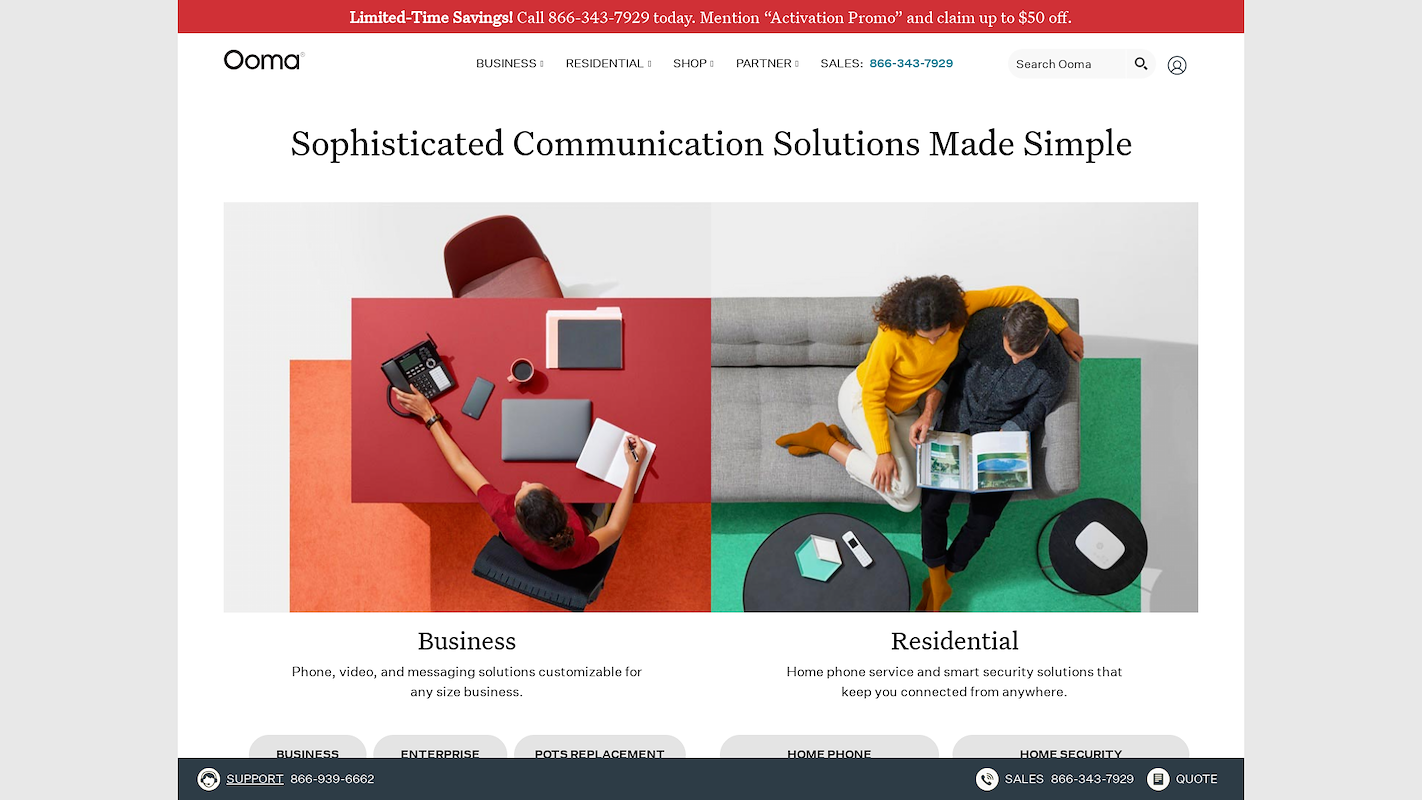
Ooma Office is a business phone service that combines voice calls with video conferences. The platform gives companies a single tool for internal collaboration and customer communication. It suits businesses that need a straightforward system for phone service and virtual meetings without complex setups.
Ooma Office's Main Features
- Supports conventional analog phones, IP phones, and virtual service through mobile and desktop applications.
- Includes a virtual receptionist, ring groups, and call parking for advanced call management.
- Provides a browser extension for access to its services.
- Offers hold music and the ability to use a VoIP number.
How Ooma Office Compares to Dialpad
Average Review score: 4.6/5 stars based on 129 G2 reviews.
- Ooma Office supports conventional analog phones and IP phones. This offers more hardware options compared to Dialpad, which operates mainly through software applications.
- The service operates without long-term contracts. This provides more flexibility for businesses that want to avoid annual commitments, a different approach from Dialpad's typical subscription plans.
- It includes a virtual receptionist to manage and route calls automatically. This function contrasts with Dialpad's AI, which assists agents with live transcription and analysis during calls.
- The platform provides a call parking feature. This lets users hold a call in a shared space for anyone to retrieve, a specific call management tool not emphasized in Dialpad's features.
Potential Drawbacks Compared To Dialpad
- Ooma Office does not offer real-time AI assistance. This is different from Dialpad, which provides live call transcriptions and in-call coaching to help agents during active conversations.
- Some users report that the service can experience call quality issues like lag. In comparison, Dialpad is generally recognized for its stable connections and clear audio.
- The platform lacks the advanced, AI-driven analytics found in Dialpad. It does not provide automated call summaries or sentiment analysis for post-call review.
Pricing and Cost-Effectiveness
Dialpad provides a more budget-friendly entry point with its Standard plan at $15 per user per month, while Ooma Office has a base price of $19.95. For advanced features, Ooma's Office Pro plan at $24.95 is slightly more cost-effective than Dialpad's Pro plan at $25.
9) Microsoft Teams Phone
Microsoft Teams Phone is a cloud-based phone system that adds PSTN calling to the Microsoft Teams platform. It integrates voice calls directly into the existing Teams workspace. The system is for businesses already invested in the Microsoft 365 ecosystem and want to unify their communications.
Microsoft Teams Phone's Main Features
- Adds PSTN calling capabilities directly within the Microsoft Teams application.
- Integrates with the broader Microsoft 365 suite, including Outlook and Calendar.
- Provides standard phone system features like auto attendants, call queues, and voicemail.
- Unifies chat, video meetings, and phone calls into a single user interface.
How Microsoft Teams Phone Compares to Dialpad
- Microsoft Teams Phone offers deep, native integration with the Microsoft 365 ecosystem. This provides a more unified workflow for companies using tools like Outlook and SharePoint compared to Dialpad's separate integrations.
- The user experience is consolidated within the familiar Teams interface. This eliminates the need for employees to learn a separate application, unlike Dialpad which operates as a standalone platform.
- Its AI capabilities are part of the broader Microsoft Copilot system. This differs from Dialpad's AI, which is built specifically for real-time voice intelligence and post-call sales analytics.
- The system leverages Microsoft's global Azure network. This provides a robust infrastructure, which can be a factor for large enterprises with specific compliance or security needs.
Potential Drawbacks Compared to Dialpad
- The setup process can be complex, particularly for organizations not already using Microsoft 365. Dialpad, in contrast, is often noted for its more direct and faster implementation as a standalone product.
- Some users find its phone-specific features less extensive than those of a dedicated VoIP provider. Dialpad offers a more specialized toolset focused entirely on business communications and contact center functions.
- Its AI features through Copilot are broad, not specialized for real-time agent coaching. This is a key difference from Dialpad's AI, which provides live assistance and transcriptions during calls.
- Licensing can be confusing as it often requires a base Microsoft 365 subscription plus a Teams Phone add-on. Dialpad's pricing structure is typically more straightforward with clear per-user tiers.
Pricing and Cost-Effectiveness
Dialpad's pricing begins at $15 per user per month. Microsoft Teams Phone pricing is an add-on to existing Microsoft 365 plans, so total cost varies. This model can be cost-effective for companies already on compatible plans but may be more expensive for others.
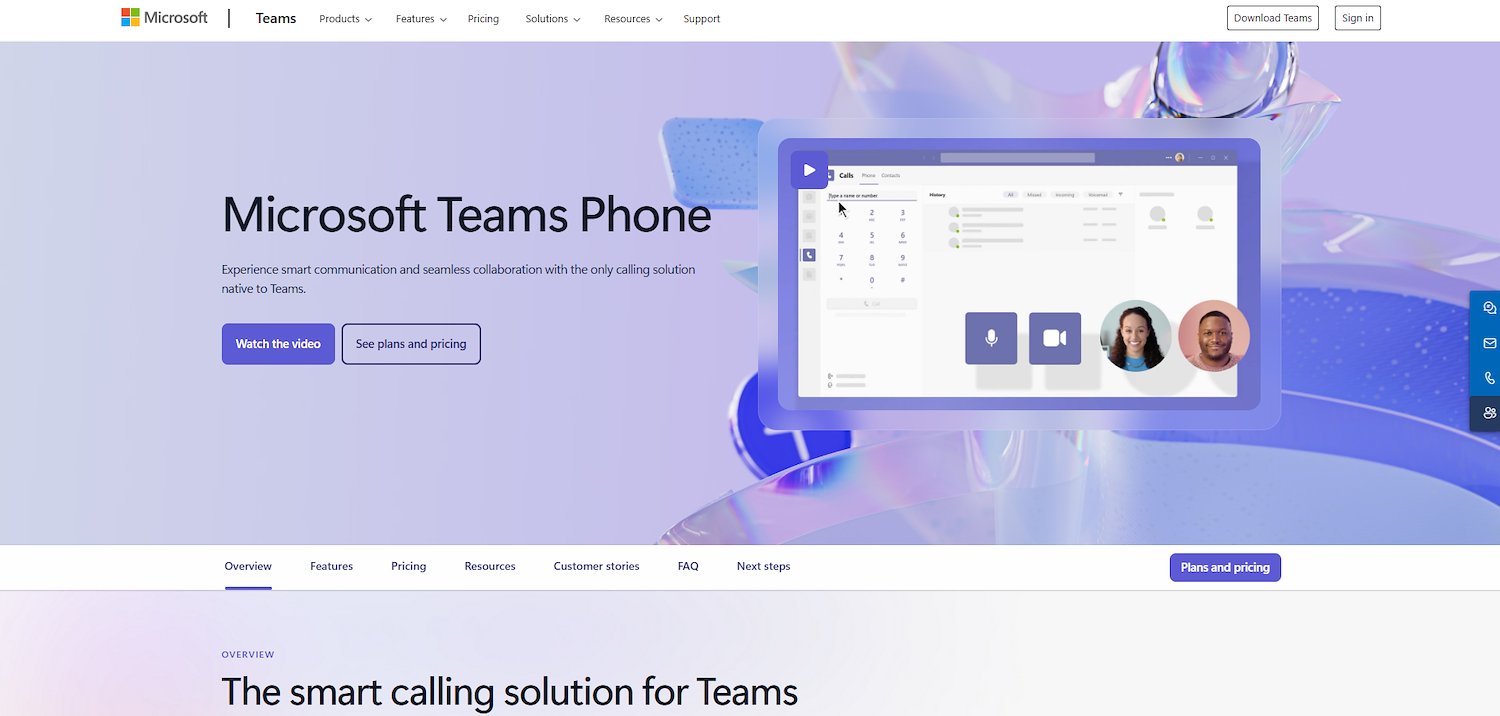
Microsoft Teams Phone is a cloud-based phone system that adds PSTN call functions to the Microsoft Teams platform. It integrates voice calls directly into the workspace. The system is for businesses invested in the Microsoft 365 ecosystem that want to unify communications.
Microsoft Teams Phone's Main Features
- It unifies business instant messaging, live chat, and audio and video conferencing in one application.
- The platform includes collaboration tools for file sharing and screen sharing during meetings.
- It provides features for meeting coordination, scheduling, and recording.
- The system allows hosts to set participant permissions to manage meeting access and interaction.
How Microsoft Teams Phone Compares To Dialpad
Average Review score: 4.4/5 stars based on 16,350 G2 reviews.
- Microsoft Teams Phone integrates natively with the Microsoft 365 suite. This creates a single workspace for users, which is different from Dialpad's standalone platform.
- It consolidates communication within the familiar Teams interface. This may reduce the learning curve for employees compared to adopting Dialpad's separate application.
- The tool includes collaboration features like file sharing and co-editing inside chats. This is a different focus from Dialpad, which centers on voice and messaging functions.
- Its AI is part of the larger Microsoft Copilot system for tasks like creating meeting notes. This contrasts with Dialpad's AI, which provides real-time coaching and transcription during calls.
Potential Drawbacks Compared To Dialpad
- Microsoft Teams Phone's AI is part of the broader Copilot system and focuses on post-call tasks like creating meeting notes. This differs from Dialpad's AI, which gives agents real-time transcription and live coaching during calls to help improve performance.
- The system adds phone functions to a collaboration platform, so it may not have the specialized call center tools of a dedicated provider. In contrast, Dialpad is built specifically for business communication and offers a more focused feature set for sales and support teams.
- Its setup process can be complex for organizations not already within the Microsoft ecosystem. Some users also report that the application uses significant system resources, which is a different experience compared to Dialpad's standalone application.
Pricing and Cost-Effectiveness
Dialpad's Standard plan is $15 per user per month, while a Microsoft Teams Essentials plan costs $4.80 per user per month. However, the Teams phone system requires an additional license on top of a Microsoft 365 subscription, making Dialpad's pricing more direct and the total cost for Teams variable.
10) Grasshopper

Grasshopper provides a virtual phone system that adds a business number to an entrepreneur's personal phone. This setup separates work and personal calls on a single device. The service includes features like custom greetings and the ability to forward calls.
It also has a conference call function. Teams can use this to host audio meetings with multiple participants, which supports collaboration without extra software.
Grasshopper's Main Features
- It provides local, toll-free, and vanity phone numbers to establish a business line.
- The system includes an automated attendant and unlimited extensions for call routing.
- It transcribes voicemails and delivers the text directly to a user's email inbox.
- The service offers access through mobile and desktop applications as well as a browser extension.
How Grasshopper Compares to Dialpad
Average Review score: 3.9/5 stars based on 154 G2 reviews.
- Grasshopper adds a business line directly to a personal cell phone. This approach differs from Dialpad, which functions as a separate, comprehensive communication application.
- It provides vanity phone numbers to help small businesses establish a brand identity, a specific feature not emphasized in Dialpad's standard plans.
- The service includes unlimited extensions for call routing. This offers a simple way to manage calls for a small team, unlike Dialpad's structure which is based on per-user seats.
- Its system transcribes voicemails and sends them to an email inbox. This provides a direct notification method, whereas Dialpad's AI focuses on transcribing live calls for real-time analysis.
Potential Drawbacks Compared To Dialpad
- Grasshopper does not offer real-time AI assistance. This is different from Dialpad, which provides live call transcriptions and in-call coaching to help agents during active conversations.
- The service is designed to add a business line to a personal phone. It does not include the integrated video conferencing or team messaging that Dialpad offers as a unified communications platform.
- It lacks the advanced, AI-driven analytics found in Dialpad. The tool does not provide automated call summaries or sentiment analysis for detailed post-call review.
Pricing and Cost-Effectiveness
Grasshopper's entry-level plan is $14 per month, slightly lower than Dialpad's $15 per-user starting price. While both offer a $25 plan, Grasshopper's pricing is based on lines and extensions, making it a cost-effective option for solopreneurs who just need a business number.
Which One Should You Go With?
Choosing a Dialpad alternative depends on your specific business needs, team size, and budget. This guide has detailed several options to help you evaluate which platform aligns with your operational goals.
If your focus is on automating sales processes, 11x offers a different approach with its digital workers. These agents handle tasks like outreach and lead qualification, allowing your sales team to concentrate on closing deals and strategic growth.



